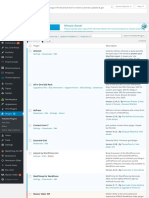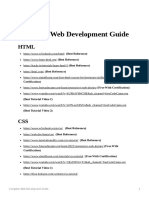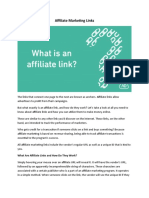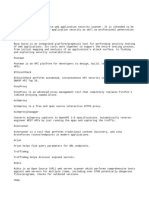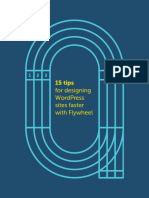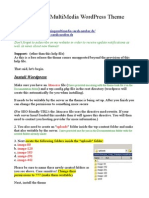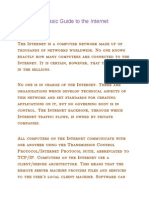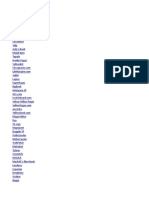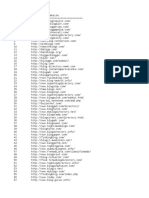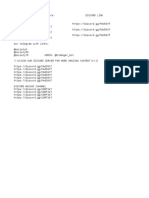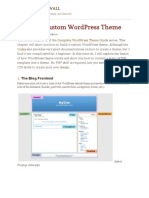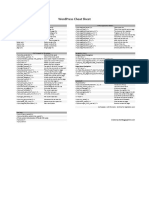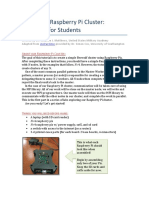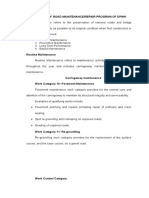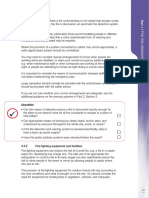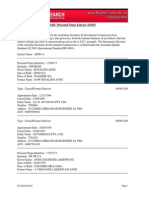Advanced
WordPress Cheat Sheet
Content Only for The Home Page Unique Image for Different Categories
<?php if(is_home() ) { include ('example.php'); } ?> <?php if (is_category('7') ):
This snippet will include the file specified, only if the user is on the home <img src="<?php bloginfo('template_url');?>/images/cat7.jpg' alt=" />
page of the site. Place this code in the index.php file. <?php elseif (is_category('8') ):
<img src="<?php bloginfo('template_url');?>/images/cat8.jpg' alt=" />
<?php endif; ?>
Styiling Different Categories This snippet assings an image (cat 7.jpg) next to each post title in the category 7 and an
<?php if (is_category('15') { image (cat8.jpg) next to each post title in category 8. Place this code in the category.php
<link rel="stylesheet" href="<?php bloginfo('template_url*); ?>/cat-‐15.css"
type="text/css" media="screen" />
<?php } else { ?> Styling Individual Posts
<link rel="stylesheet" href="<?php bloginfo(stylesheet_url*); ?>" <div id="post-‐<?php the_ID();?>">
type="text/css" media="screen" /> This snippet will assign the post ID to the DIV. For example, if the ID for the post is 8, that
<?php } ?> line will echo as <div id="post-‐8"></div>. Now you can style that individual post in the CSS
This snippet assigns a specific stylesheet (category-‐15.css) to category 15 as #post-‐8. Place this code within the loop.
and will assign the rest of the site the default stylesheet (style.css). Place this code in the
<head> area.
Site Page Links
<ul>
Previous & Next Posts Links <li<?php if(is_home()) { ?> class="current_page_item"<?php } ?>><a href="
<?php next_posts_link('Next Entries »') ?> <?php bloginfo('home'); ?>">home</a></li>
<?php previous_posts_link('» Older Entries'); ?> <?php wp_list_pages('sort_column=menu_order&depth=1&title_li='); ?>
This snippet will echo "Next Entries >>" with a link to the next set of posts. The second snippet </ul>
will echo "<< Previous Entries" with a link to the previous set of posts. Place this code outside This snippet will first echo the text "home" with a link to the home page. Next, it will echo
the loop. the WordPress pages links in a list, in order defined by your settings, excluding the child
pages, and excluding a title header for the list. If one of the pages in the list is active, the
link for that page will be assigned the class"corrent_page_item", which can now be styled
Dyniamic Page Titles
<?php
if (is_home()) { echo bloginfo('name'); } elseif (is_404()) { echo 'WPCandy » 404'; } elseif Query Posts
(is_search()) { echo 'WPCandy » Search Results'; } else { echo 'WPCandy » '; wp_title(''); } <?php query_posts('cat=2&showposts=5');?>
?> This snippet will display the 5 latest posts from the only category 2. Place this code right
If the home page is active, the title will display the name of the site. If the 404 page is active, before the loop.
the title will echo 'WPCandy » 404'. If the Search Results page is active, the title will echo
‘WPCandy » Search Results’. If any other page on the site is active, the title will display
Page Template Details
<?php
CSS Theme Details /*
/* Template Name: Gallery
Theme Name: StartBlogging */
Description:Description goes here ?>
Theme URL: http://startbloggingonline.com/ This snippet defines a page template. You will also need to have a corresponding file to use
Version: 2.0 as the new page template.For example, in this case, you would create a gallery.php file.
Author: Mike W.
Author URL: http//startbloggingonline.com/
Template: Degine a parent template (optional) Unique Template for Categories
*/ <?php
This snippet defines a theme. WordPress will read this and assign it to the theme. Use the $post = $wp_query-‐ >post;
'Template:' to define a parent template for the theme. Place this code at the top of the
syle.css file. if ( in_category('3') ) {
include(TEMPLATEPATH . '/cat3.php’);
The Loop } elseif ( in_category('4') ) {
<?php if (have_posts()) : ?> include(TEMPLATEPATH . '/cat4.php');
<?php while(have_posts()) : the_post();?>
// Post content here (Custom HTML & PHP code) } else {
<?php endwhile; ?> include(TEMPLATEPATH . '/cat.php');
<?php else : ?> } ? >
<?php endif; ?> This snippet will assign a uniqe template to certain categories. In this case, 'cat3.php' will
This snippet is the basic form of the loop. WordPress will read the code between the be assigned to 'Category3', 'cat4.php' will be assigned to Category 4', and the rest of the
beginning of the loop and the end of the loop, and display it accordingly on each post or page. categories will be assigned 'cat.php'. Place this code at the top of category.php.
Any HTML or PHP placed inside the loop will be used for each post. Place this code in any
Tags Cloud
<?php wp_tag_cloud('smallest=1&largest=9&'); ?>
This snippet will create a tag cloud, in alphabetical order, with the smallest text at 1 pt and
the largest text at 9 pts.
Created by StartBloggingOnline.com
